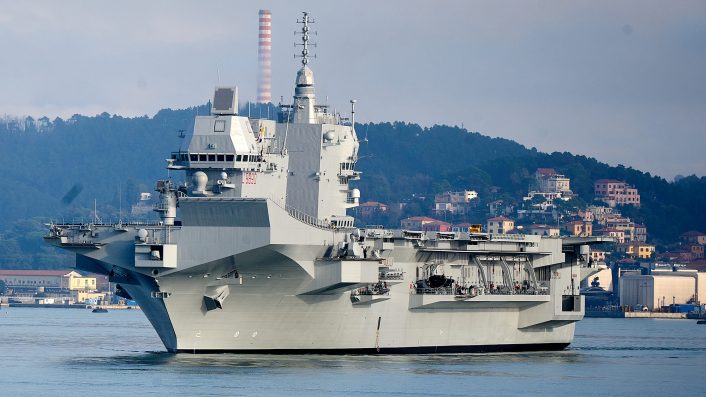The ceremony, held in Trieste, coincided with the 71st anniversary of the city’s return to Italy and marks the ship’s transition into fully operational service.
The Italian Navy’s new amphibious assault ship, LHD (Landing Helicopter Dock) Trieste, received its battle flag during a ceremony held on board at Molo Bersaglieri, in Trieste, northeastern Italy, 26 October 2025. The event coincided with the 71st anniversary of the city’s return to Italy, so it should highlight the symbolic link between the ship and the city whose name it bears.
The ceremony marking the awarding of the Bandiera di Guerra (Battle Flag) is a symbolic milestone in the life of any unit of the Italian Navy. The flag, offered in the name of the Nation, embodies the honor, traditions and values of the Italian Armed Forces and transforms the ship into an operational warship according to the laws of the State. Although the amphibious assault ship was officially handed over to the Military Navy in December 2024, the presentation of the Battle Flag by the President of the Republic formally marks its full entry into active service: from now on, Trieste is recognized not only as a ship, but as a sovereign extension of Italy at sea, ready to represent the country in national and international operations.
As explained, the timing of the event also had a strong historical resonance: on October 26, 1954, Trieste officially returned to Italian administration after almost a decade of uncertainty following the Second World War. At the end of the conflict, the city had been occupied by Yugoslav partisans and then placed under Allied military control, becoming part of the Free Territory of Trieste, divided into two zones: Zone A under Anglo-American administration and Zone B under Yugoslav control. The London Memorandum of 1954 finally resolved the issue, returning Zone A, including the city of Trieste, to Italy, while Zone B was assigned to Yugoslavia.
The battle flag was formally presented to the ship’s commander, Captain Francesco Marzi, by the mayor of Trieste, Roberto Dipiazza, who underlined the emotional and historic importance of the occasion. “In 25 years as mayor, I have experienced many moments of great emotion, but the arrival of Trieste, flying the Italian flag and carrying the name of the city around the world, has been one of the most moving,” said Dipiazza.
The ceremony, broadcast live on the YouTube channel of the Italian Navy, was attended by Italian government and military leaders, including the Minister of Defense, Guido Crosetto, the Minister of Parliamentary Relations, Luca Ciriani, the Minister of Justice, Carlo Nordio, the Undersecretary of Economy and Finance, Sandra Savino, and Laura Mattarella, daughter of the President of the Republic, which acts as godmother of the ship.
Minister Crosetto underlined the broader strategic importance of the event. “For Trieste, this is a great day because its name will remain on this ship for decades. It is an important act of respect by the Armed Forces and the Navy towards the city and its history. But it is also a significant moment for Italy, because this confirms that our Navy is among the most important maritime forces in the world in efficiency, deterrence and capability. Very few navies operate more than one aircraft carrier, and Italy is among them.”
Following the traditional formula, the mayor turned to Captain Marzi and declared: “Commander, on behalf of the city of Trieste, I present to you the battle flag of the ship Trieste.” The flag was then raised aboard the ship, where four helicopters (two EH-101 and two SH-90) were parked on the flight deck, accompanied by rifle salvos. At the same time, hundreds of citizens gathered in the Piazza dell’Unità d’Italia witnessed the event on a large screen, where an official flag-raising ceremony took place simultaneously.
#Trieste #26over consecrates the Bandiera di Combattimento to #shipTriestea symbolic moment that marks the beginning of the operational life #AlServizodelPaese.
The flag represents the Nazi Unit and the legacy of the ship, its equipment and the Country.
#ItalianNavy… pic.twitter.com/HxiCboqIIq– Marina Militare (@ItalianNavy) October 26, 2025
The delivery of the Battle Flag marks a new milestone in Trieste’s transition to full operational service. Delivered to the Italian Navy on December 7, 2024, the 33,000-tonne amphibious assault ship was built by Fincantieri at the Castellammare di Stabia and Muggiano shipyards. At 245 meters in length and with a flight deck of 230 meters, the Trieste is the largest combat ship built for the Italian Navy since World War II.
Designed to perform multiple roles, the ship can carry more than 1,000 personnel and operate as an aircraft carrier and command and control platform for joint operations. It has a floodable landing craft deck, a large vehicle deck, and can operate F-35B Lightning II aircraft (which are gradually replacing the AV-8B+ Harrier II aircraft still in service) as well as helicopters. The ship serves as the flagship of the Italian Navy’s Amphibious Task Group and complements the aircraft carrier strike capability provided by ITS Cavour.
When the ship entered service in late 2024, the Italian Navy described Trieste as a symbol of national technological excellence, strengthening Italy’s capacity for power projection, humanitarian assistance and maritime security.

The ceremony in Trieste linked Italy’s naval future to one of its most important post-war milestones. For the city it was a moment of pride and memory; For the Italian Navy, it marked the official transition of its newest and most versatile warship to active service.



